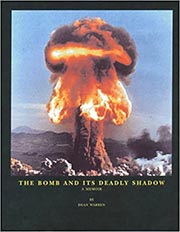The Bomb and Its Deadly Shadow
by Dean Warren
Reviewed January 9, 2005
 The Bomb and Its Deadly Shadow is a short (42 page) memoir of Dr. Stafford (Staff) L. Warren written by his son Dean Warren. This book recounts the career as one of the leading scientists in the effects of radiation on humans. Following post-doctoral work at Johns Hopkins and Harvard he joined the faculty of the Department of Radiology in the University of Rochester's School of Medicine. There he explored the use of X-rays, radium and radon gas and their practical medical application.
The Bomb and Its Deadly Shadow is a short (42 page) memoir of Dr. Stafford (Staff) L. Warren written by his son Dean Warren. This book recounts the career as one of the leading scientists in the effects of radiation on humans. Following post-doctoral work at Johns Hopkins and Harvard he joined the faculty of the Department of Radiology in the University of Rochester's School of Medicine. There he explored the use of X-rays, radium and radon gas and their practical medical application.
In 1943, as Colonel in the Army Medical Corps, Dr. Warren was appointed Chief of the Medical Section of the Manhattan Project. In this critical position he was responsible for the radiation safety of all personnel involved, both at the University of Chicago and then at the test site of the world's first nuclear bomb in Alamogordo, New Mexico.
As the radiological safety director for the test, he set out to survey the fallout soon after it. He found a radiological disaster: "[T]he dust outfall from various portions of the [radioactive] cloud was potentially a very dangerous hazard over a band almost 30 miles wide extending almost 90 miles northeast of the site."
After leading a research team to the cities of Hiroshima and Nagasaki to survey the residual radiation, he was the Chief of the Radiological Safety Section of the Joint Task Force for the early weapons tests at Bikini Atoll during Operation Crossroads. Afterwards he served as a consultant for the Atomic Energy Commission on medical matters.
In 1971 Dr. Warren received the Enrico Fermi Award of the Atomic Energy Commission for his role in "the early development of atomic energy so as to insure the protection of man and the environment." Dr. Warren passed away in 1981.
The book lacks the depth that one would expect in a traditional biography. Although the author references an oral history that his father gave, one wishes that he could have brought more details and insight to this story. The personal anecdotes do provide a nice touch, allowing us to glimpse behind the fences of the Manhattan Project into the homes of the people who worked there. Those looking for a greater insight into the medical aspects of the early days of the atomic age will have to look elsewhere. Available at amazon.com